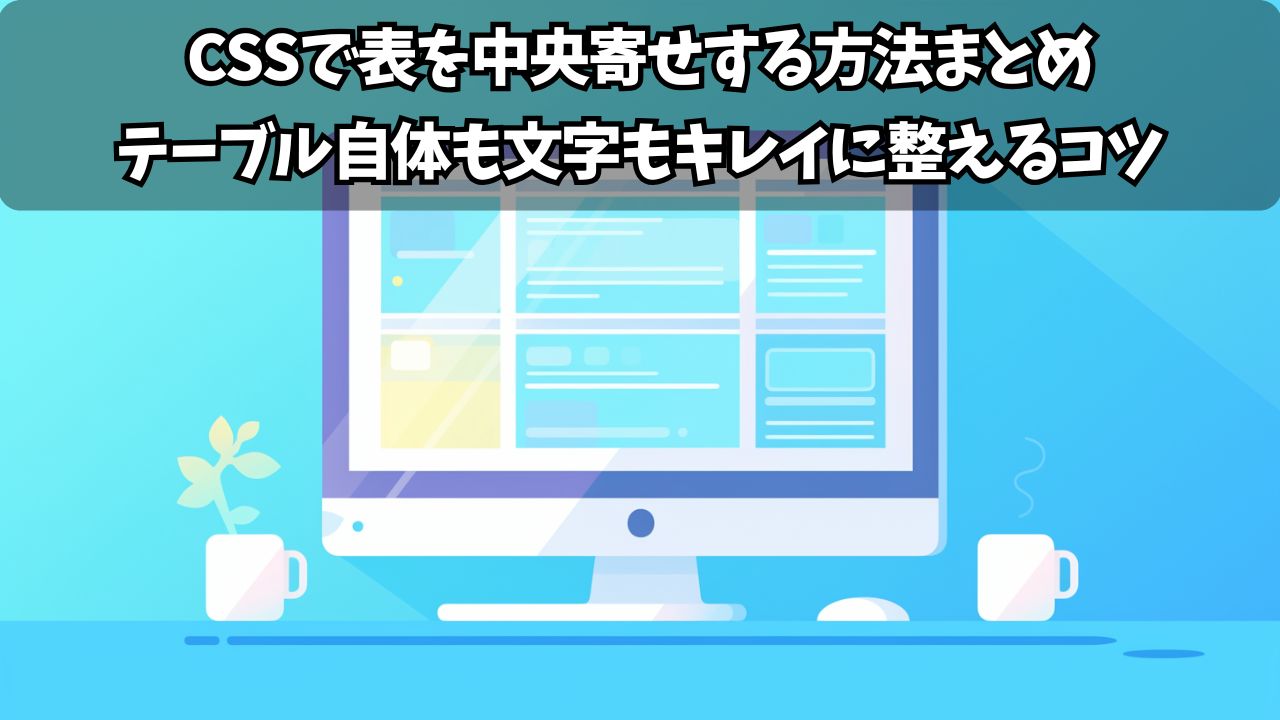Webサイトを作っていて、HTMLの<table>(表)を中央に寄せたい場面は意外と多いです。
でも「テーブル全体を中央寄せしたい」「中の文字を中央にしたい」「縦にも中央寄せしたい」など、どのケースかによってCSSの書き方が変わるので混乱しがち。
この記事では、CSSで表(テーブル)を中央に寄せる方法を、具体例付きでわかりやすく解説します。
読み終えるころには、あなたのページのテーブル配置がきれいに整っているはずです。
まず整理しよう:テーブルの中央寄せには3つのパターンがある
表の中央寄せと一口に言っても、実は以下の3つのパターンがあります:
パターン1:テーブル全体をページ内で中央寄せ
こんなとき: 表をページの中央に配置したい
パターン2:テーブル内の文字を中央寄せ
こんなとき: セルの中の文字を見やすく整えたい
パターン3:テーブルを縦方向にも中央寄せ
こんなとき: 画面全体の真ん中に表を配置したい
それぞれ異なるCSSテクニックが必要なので、順番に見ていきましょう。
1. 表(テーブル)全体を中央寄せする方法

基本:margin autoを使った横中央寄せ
まずは、表全体をページの横方向で中央に寄せたい場合です。
一番よく使うのはmargin: autoを使った方法です。
HTML:
<table class="center-table">
<thead>
<tr>
<th>商品名</th>
<th>価格</th>
<th>在庫</th>
</tr>
</thead>
<tbody>
<tr>
<td>商品A</td>
<td>1,000円</td>
<td>あり</td>
</tr>
<tr>
<td>商品B</td>
<td>1,500円</td>
<td>なし</td>
</tr>
</tbody>
</table>
CSS:
.center-table {
margin-left: auto;
margin-right: auto;
/* またはまとめて */
margin: 0 auto;
/* 幅を必ず指定する */
width: 60%;
/* 見た目を整える */
border-collapse: collapse;
border: 1px solid #ddd;
}
.center-table th,
.center-table td {
padding: 10px;
border: 1px solid #ddd;
}
.center-table th {
background-color: #f5f5f5;
font-weight: bold;
}
重要なポイント
widthを必ず指定する
問題: margin: auto は幅が決まっていないと効きません。 解決: 必ず width を指定してください。
/* ❌ 間違い:幅がないので中央寄せされない */
.table {
margin: 0 auto;
}
/* ✅ 正解:幅を指定することで中央寄せされる */
.table {
margin: 0 auto;
width: 50%; /* または 600px など */
}
レスポンシブ対応の考慮
パーセント指定: 画面サイズに応じて自動調整
.center-table {
margin: 0 auto;
width: 80%; /* 画面の80%の幅 */
max-width: 800px; /* 最大幅を制限 */
}
ピクセル指定: 固定幅にしたい場合
.center-table {
margin: 0 auto;
width: 600px;
}
その他の中央寄せ方法
flexboxを使った方法
説明: 親要素でflexboxを使用する方法です。
.table-container {
display: flex;
justify-content: center;
}
.table {
/* widthの指定は不要 */
border-collapse: collapse;
}
text-alignを使った方法
説明: 親要素で text-align: center を使用する方法です。
.table-container {
text-align: center;
}
.table {
display: inline-table; /* 重要:inline-tableにする */
border-collapse: collapse;
}
テーブル全体を中央に置くにはmargin: autoが最も一般的で確実です。
次は、表の中の文字を中央に寄せる方法を見ていきましょう。
2. 表の中の文字を中央に寄せる方法
横方向の中央寄せ(text-align)
テーブルのセル内(<td>や<th>)のテキストを中央に寄せるにはtext-align: centerを使います。
CSS:
/* 全てのセルを中央寄せ */
.center-text td,
.center-text th {
text-align: center;
}
/* 特定の列だけ中央寄せ */
.center-text .price-column {
text-align: center;
}
/* ヘッダーだけ中央寄せ */
.center-text th {
text-align: center;
}
/* データセルは左寄せ、ヘッダーは中央寄せ */
.center-text td {
text-align: left;
}
.center-text th {
text-align: center;
}
HTML:
<table class="center-text">
<thead>
<tr>
<th>商品名</th>
<th class="price-column">価格</th>
<th>詳細</th>
</tr>
</thead>
<tbody>
<tr>
<td>商品A</td>
<td class="price-column">1,000円</td>
<td>高品質な商品です</td>
</tr>
</tbody>
</table>
縦方向の中央寄せ(vertical-align)
セル内のテキストを縦方向(上下方向)で中央に揃えるにはvertical-align: middleを使います。
CSS:
.vertical-center td,
.vertical-center th {
vertical-align: middle;
height: 60px; /* 高さを指定して効果を分かりやすく */
}
HTML:
<table class="vertical-center">
<tr>
<td>この文字は<br>縦方向で<br>中央寄せされます</td>
<td>通常の<br>テキスト</td>
</tr>
</table>
横・縦両方の中央寄せ
最もよく使われるパターンは、横と縦の両方で中央寄せすることです。
CSS:
.fully-centered td,
.fully-centered th {
text-align: center; /* 横方向の中央寄せ */
vertical-align: middle; /* 縦方向の中央寄せ */
padding: 15px;
}
セルごとに個別設定
用途別のセル設定例:
/* 数値列:右寄せ */
.table .number {
text-align: right;
vertical-align: middle;
}
/* タイトル列:左寄せ、上寄せ */
.table .title {
text-align: left;
vertical-align: top;
}
/* アクション列:中央寄せ */
.table .action {
text-align: center;
vertical-align: middle;
}
vertical-alignの注意点
重要: vertical-alignはテーブルセルやインライン要素にしか効きません。
/* ✅ 正解:テーブルセルなので効く */
td {
vertical-align: middle;
}
/* ❌ 間違い:divなどのブロック要素には効かない */
div {
vertical-align: middle; /* 効果なし */
}
このように、テーブルの中の文字を中央に寄せるにはtext-alignとvertical-alignを組み合わせるのが基本です。
次は、テーブルそのものを上下方向に中央に寄せる方法を紹介します。
3. テーブルを縦方向にも中央寄せしたいとき

flexboxを使った完全中央寄せ
テーブル自体を、ページの上下の中央に配置したいケースもあります。
この場合、flexboxを使うのが最も簡単で確実です。
HTML:
<div class="full-center-wrapper">
<table class="centered-table">
<thead>
<tr>
<th>項目</th>
<th>値</th>
</tr>
</thead>
<tbody>
<tr>
<td>売上</td>
<td>1,000万円</td>
</tr>
<tr>
<td>利益</td>
<td>200万円</td>
</tr>
</tbody>
</table>
</div>
CSS:
.full-center-wrapper {
display: flex;
justify-content: center; /* 横方向の中央寄せ */
align-items: center; /* 縦方向の中央寄せ */
/* 重要:親要素の高さを指定 */
height: 100vh; /* 画面の高さいっぱい */
/* 背景色で分かりやすく */
background-color: #f8f9fa;
}
.centered-table {
border-collapse: collapse;
background-color: white;
box-shadow: 0 4px 6px rgba(0, 0, 0, 0.1);
}
.centered-table th,
.centered-table td {
padding: 15px 20px;
border: 1px solid #ddd;
text-align: center;
}
.centered-table th {
background-color: #007bff;
color: white;
}
CSS Gridを使った方法
CSS Gridでも同様の効果が得られます。
CSS:
.grid-center-wrapper {
display: grid;
place-items: center; /* 縦横両方の中央寄せ */
height: 100vh;
background-color: #f8f9fa;
}
position absoluteを使った方法
従来の方法ですが、今でも使えます。
CSS:
.absolute-center-wrapper {
position: relative;
height: 100vh;
}
.absolute-centered-table {
position: absolute;
top: 50%;
left: 50%;
transform: translate(-50%, -50%);
border-collapse: collapse;
}
重要なポイント
親要素の高さ指定が必須
問題: 親要素の高さを指定しないと、縦中央寄せは効きません。
/* ❌ 高さがないので縦中央寄せされない */
.wrapper {
display: flex;
align-items: center;
}
/* ✅ 高さを指定することで縦中央寄せされる */
.wrapper {
display: flex;
align-items: center;
height: 100vh; /* または具体的なpx値 */
}
高さの指定方法
/* 画面全体の高さ */
height: 100vh;
/* 固定の高さ */
height: 500px;
/* 親要素の100% */
height: 100%;
/* 最小の高さ */
min-height: 100vh;
これでテーブル全体を画面中央に、縦横ともに配置することができます。
最後に、よくある間違いと注意点を確認しておきましょう。
4. よくある間違いと注意点
間違い1:margin autoで上下中央寄せしようとする
問題: 多くの人が、テーブルを上下中央に置きたいときにmargin: autoだけでやろうとしますが、上下には効きません。
/* ❌ 間違い:上下の中央寄せはされない */
.table {
margin: auto;
width: 50%;
}
解決策: 上下中央寄せはflexやgridを使う必要があります。
/* ✅ 正解:flexで上下中央寄せ */
.wrapper {
display: flex;
justify-content: center;
align-items: center;
height: 100vh;
}
間違い2:vertical-alignをブロック要素に使う
問題: vertical-alignはテーブルセルやインライン要素にしか効きません。
/* ❌ 間違い:divには効かない */
.container {
vertical-align: middle;
}
解決策: ブロック要素の縦中央寄せにはflexやgridを使います。
/* ✅ 正解:flexで縦中央寄せ */
.container {
display: flex;
align-items: center;
}
間違い3:widthを指定せずにmargin autoを使う
問題: 幅が指定されていないとmargin: autoは効きません。
/* ❌ 間違い:幅がないので中央寄せされない */
.table {
margin: 0 auto;
}
解決策: 必ず幅を指定します。
/* ✅ 正解:幅を指定する */
.table {
margin: 0 auto;
width: 80%;
}
間違い4:レスポンシブ対応を忘れる
問題: 固定幅だけ指定すると、スマホで表示が崩れます。
/* ❌ 問題:スマホで横スクロールが発生 */
.table {
margin: 0 auto;
width: 800px;
}
解決策: max-widthと組み合わせます。
/* ✅ 改善:レスポンシブ対応 */
.table {
margin: 0 auto;
width: 90%;
max-width: 800px;
}
/* さらにスマホ対応 */
@media (max-width: 768px) {
.table {
width: 95%;
font-size: 14px;
}
.table th,
.table td {
padding: 8px 4px;
}
}
5. 実用的なテーブルスタイル例

パターン1:シンプルなデータテーブル
HTML:
<div class="table-container">
<table class="data-table">
<thead>
<tr>
<th>ID</th>
<th>名前</th>
<th>年齢</th>
<th>職業</th>
</tr>
</thead>
<tbody>
<tr>
<td>001</td>
<td>田中太郎</td>
<td>28</td>
<td>エンジニア</td>
</tr>
<tr>
<td>002</td>
<td>佐藤花子</td>
<td>32</td>
<td>デザイナー</td>
</tr>
</tbody>
</table>
</div>
CSS:
.table-container {
padding: 20px;
}
.data-table {
margin: 0 auto;
width: 80%;
max-width: 600px;
border-collapse: collapse;
box-shadow: 0 2px 8px rgba(0,0,0,0.1);
}
.data-table th {
background-color: #4CAF50;
color: white;
padding: 12px;
text-align: center;
font-weight: bold;
}
.data-table td {
padding: 12px;
text-align: center;
border-bottom: 1px solid #ddd;
}
.data-table tr:nth-child(even) {
background-color: #f9f9f9;
}
.data-table tr:hover {
background-color: #f5f5f5;
}
パターン2:価格表テーブル
HTML:
<div class="pricing-container">
<table class="pricing-table">
<thead>
<tr>
<th>プラン</th>
<th>月額料金</th>
<th>機能</th>
</tr>
</thead>
<tbody>
<tr>
<td>ベーシック</td>
<td class="price">¥1,000</td>
<td>基本機能</td>
</tr>
<tr class="featured">
<td>プレミアム</td>
<td class="price">¥2,000</td>
<td>全機能</td>
</tr>
</tbody>
</table>
</div>
CSS:
.pricing-container {
display: flex;
justify-content: center;
align-items: center;
min-height: 60vh;
background: linear-gradient(135deg, #667eea 0%, #764ba2 100%);
}
.pricing-table {
background: white;
border-radius: 10px;
overflow: hidden;
box-shadow: 0 10px 30px rgba(0,0,0,0.3);
width: 90%;
max-width: 500px;
}
.pricing-table th {
background-color: #333;
color: white;
padding: 20px;
text-align: center;
font-size: 18px;
}
.pricing-table td {
padding: 20px;
text-align: center;
vertical-align: middle;
border-bottom: 1px solid #eee;
}
.pricing-table .price {
font-size: 24px;
font-weight: bold;
color: #e74c3c;
}
.pricing-table .featured {
background-color: #fff3cd;
}
.pricing-table .featured .price {
color: #d39e00;
}
パターン3:レスポンシブ対応テーブル
CSS:
.responsive-table {
margin: 0 auto;
width: 95%;
max-width: 800px;
border-collapse: collapse;
}
.responsive-table th,
.responsive-table td {
padding: 12px;
text-align: center;
border: 1px solid #ddd;
}
/* タブレット対応 */
@media (max-width: 768px) {
.responsive-table {
width: 100%;
font-size: 14px;
}
.responsive-table th,
.responsive-table td {
padding: 8px 4px;
}
}
/* スマホ対応:縦積み表示 */
@media (max-width: 480px) {
.responsive-table,
.responsive-table thead,
.responsive-table tbody,
.responsive-table th,
.responsive-table td,
.responsive-table tr {
display: block;
}
.responsive-table thead tr {
position: absolute;
top: -9999px;
left: -9999px;
}
.responsive-table tr {
border: 1px solid #ccc;
margin-bottom: 10px;
padding: 10px;
}
.responsive-table td {
border: none;
position: relative;
padding-left: 50%;
text-align: left;
}
.responsive-table td:before {
content: attr(data-label) ": ";
position: absolute;
left: 6px;
width: 45%;
padding-right: 10px;
white-space: nowrap;
font-weight: bold;
}
}
まとめ:用途に応じてCSSを使い分けよう
CSSでテーブル(表)を中央に寄せる方法は、目的に応じて複数のパターンがあります。
基本パターンのまとめ
テーブル全体の横中央寄せ:
.table {
margin: 0 auto;
width: 80%; /* 必須 */
}
セル内テキストの中央寄せ:
.table td,
.table th {
text-align: center; /* 横方向 */
vertical-align: middle; /* 縦方向 */
}
テーブル全体の完全中央寄せ:
.wrapper {
display: flex;
justify-content: center;
align-items: center;
height: 100vh;
}
使い分けのポイント
- 横方向の中央寄せ:
margin: auto+widthが最も確実 - テキストの中央寄せ:
text-align: center+vertical-align: middle - 完全な中央寄せ:
flexboxが最も簡単で強力 - レスポンシブ対応:
max-widthと メディアクエリを組み合わせる
よくある用途別のおすすめ
データ表示テーブル:
- テーブル全体は
margin: autoで中央寄せ - ヘッダーは
text-align: center - データ列は内容に応じて左寄せ・右寄せ・中央寄せを使い分け
価格表・比較表:
flexboxで画面中央に配置- セル内容は
text-align: center+vertical-align: middle
フォーム内のテーブル:
- 親要素内で
margin: autoによる中央寄せ - ラベルは左寄せ、入力欄は適切な幅設定








コメント